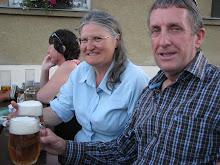
We were very excited to meet our dear friend Gerti, in Konigswinter, on the banks of the Rhine. We first met Gerti, her late husband Willi, and daughter Tanja when they emigrated to Australia. Gerti and Willi joined my English classes at Surfers' Paradise on the Gold Coast in 1982.
While in Australia we had enjoyed a southern hemisphere Christmas meal together and were invited to share a northern hemisphere meal with Gerti, her eldest daughter Martina and their family in Muhlheim.
Muhlheim, we were told has the highest unemployment rates in Germany. It is part of one of the most densely populated conurbations in the world. Martina works for the Education Department as a school inspector.
 Martina
MartinaThe fire was blazing and the Christmas tree was decorated in the lounge. We picked up Martina's mother-in-law and sat in on a service at a church in Duisburg. It was so crowded that we had to sit in an annexe and watch it televised. We were told that for many Germans it is the only time that they go to church during the year.
Christmas is celebrated on the 24th rather than the 25th like we do it. We ate fried duck with orange sauce, and chocolate mousse. We enjoyed sharing our stories of Christmas meals we have had around the world. Martina's children Anna and Eve played the piano and sang for us.
 Eve and Anna
Eve and AnnaThe education system is changing in Germany and they are reducing the high school year by one year. This will mean that there will be twice as many students trying to get into universities and training programmes. Many families are thinking of sending their children to high schools overseas to avoid being caught up in the change. Eve is thinking of spending her year in another country and it could well be New Zealand.
Each day is getting colder and colder and it is dark about 4pm. We have to scrape the ice off the car windows in the mornings and any washing left outside freezes! Everyone uses their outdoor area-deck or terrace- to keep bottles of drink, leftover food and cakes chilled when the refrigerators are full.
On the 25th of December, we were invited to have a meal with Gerti's friend Adi, and his family, in Bornheim. Adi and Gerti visited us in New Zealand about 5 years ago. Bornheim is a fertile area where fruit and vegetables are grown in fields and plastic houses. Adi used to grow flowers for the wholesalers but has now retired.
 Adi is to the left of Gerti.
Adi is to the left of Gerti. Adi
Adi
 Adi is to the left of Gerti.
Adi is to the left of Gerti. Adi
AdiAdi did a great job preparing everything himself and we had chicken in a creamy sauce with locally grown vegetables and a chocolate pudding.
Both Gerti and Adi are survivors of the tsunami in Phuket. It was an anxious time for us as we waited to hear from them after the tsunami and we are so glad to be able to enjoy their company again.
Adi had a hip replacement operation 3 months ago and has been walking regularly to strengthen it. He plans to walk Jacob's Way (also known as The Pilgrim's Walk) in mid May and will walk 30 kms a day for 90 days to cover around 2700 kms in total from his home near Bonn in Germany through Limogne in France and ending in Santiago de Compostela in Spain. He will take a tent and buy food along the way. We joined Adi on one of his daily preparatory walks through the icy trails near his home.

We have to get out and walk everyday to burn up all the excess calories from the wonderful meals our hosts have cooked us. The Rhine is a pleasant place to walk and we have looked around Bad Honnef further up the Rhine from Konigswinter and also Dollendorf in the opposite direction.
Gerti studied psychotherapy and cares for an elderly lady a few times a week so when she is working we take the train and visit some of the local area. We had to go to Cologne to buy onward train tickets and took a quick visit to the Dom- Cathedral. Construction was started in 1248 but it wasn't finished until 1880. It was not bombed during WW11 because its 157m high spires were useful for the pilots to navigate in a time when radar was not so reliable.





